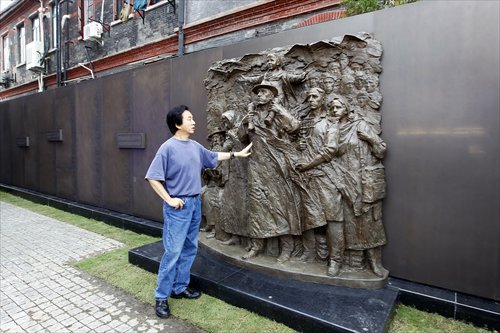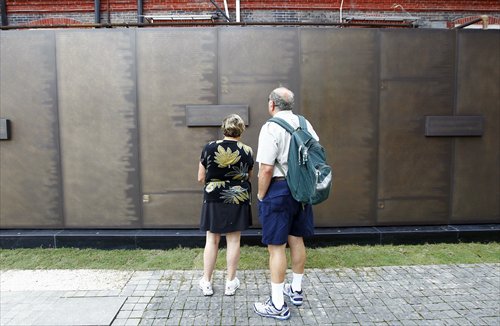

Chinese artist He Ning stands next to the memorial wall at the Shanghai Jewish Refugees Museum.

Jewish couple Bernie and Lisa Deutsch found the name of a deceased uncle on the wall.
A memorial wall, featuring the names of 13,732 Jews who had found refuge in Shanghai in the 1930s and 1940s, was unveiled at the Shanghai Jewish Refugees Museum this Tuesday.
"People who once fled from their homes during Nazi persecution, mostly under very difficult conditions, found shelter in Shanghai. Today we are able to give their names ... This is one reason we're here," German author Sonja Muehlberger said in the unveiling ceremony. Muehlberger, the child of two Jewish refugees, was born in Shanghai in 1939 and lived in the city until she was eight.
Shanghai was a haven for European Jews fleeing the Nazis between 1937 and 1945, when the Japanese army-occupied city was the only destination in the world that would accept refugees without visas. Nearly 20,000 Jews, from countries including Germany, Austria, Poland, the former Czechoslovakia and Latvia, crammed in the city, mostly in Hongkou district, in an area called the "Shanghai ghetto." Most of those who found shelter in the city lived to see the end of World War II and the defeat of Nazism.
The recently unveiled wall, which is 34 meters long and 2.5 meters tall, is composed of 26 copper plates and features a sculpture depicting Jewish refugees at one end. Most of the names inscribed on the wall came from a "foreigners' list" compiled by the local police department in 1944. The list was stolen by an Austrian, who took it to Vienna in 1947. Muehlberger discovered the list while doing research for her book, Exil Shanghai 1938-1947, which she coauthored in 2000. Muehlberger said that the list was typed by three Jewish girls, aged 14, 15 and 16, employed by occupying Japanese forces in Shanghai for a census project.
The Israeli government and the Shanghai Jewish Refugees Museum also contributed to the list of names. The names are also stored in a digital database inside the museum. This database contains other information, such as the gender, age and date of arrival of the refugees.
"Most of the names are of people who were still alive in 1944. This is different from other walls, where you have gravestones for the dead. This wall (commemorates) those people who survived in Shanghai," Muehlberger said.
Chinese painter and sculptor He Ning, along with faculty members from the Department of Sculpture at the China Central Academy of Fine Arts, designed the wall.
"We initially thought of building the wall with black or white marble, engraved with golden lettering," He Ning said. "The effect was like a tombstone, and that's exactly the effect we wanted to avoid. We eventually picked copper as the material, and the dark color fitted perfectly with the surroundings."
Bernie and Lisa Deutsch, a Jewish couple from Boston, US, found the name of a deceased uncle on the wall when visiting the museum as part of their tour of Shanghai. "We came here because we're Jewish - my parents and their siblings were all from Germany, and my uncle escaped to Shanghai when he was young. I consider us very lucky to come here and see this," Bernie Deutsch told the Global Times.
Memorial wall honors Jewish refugees
2014-09-03Copyright ©1999-2018
Chinanews.com. All rights reserved.
Reproduction in whole or in part without permission is prohibited.